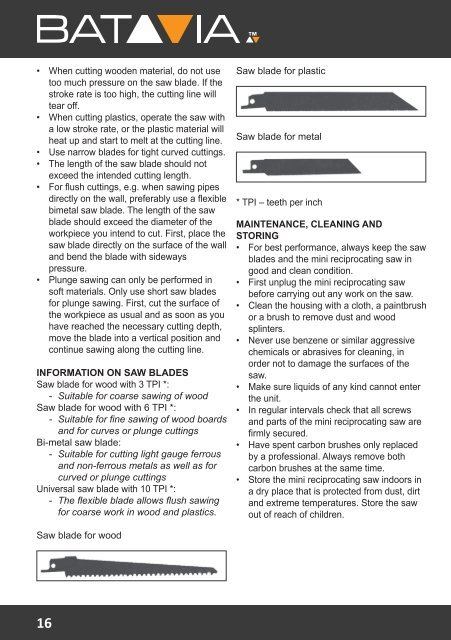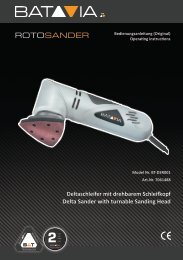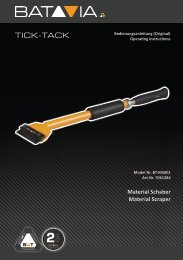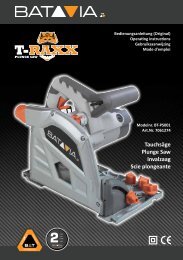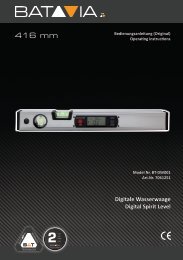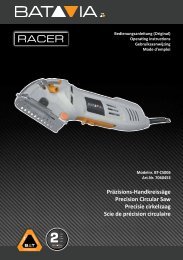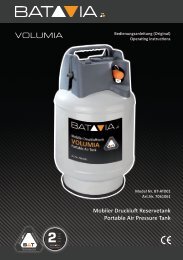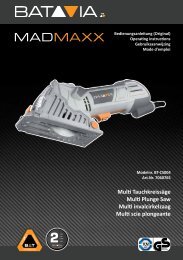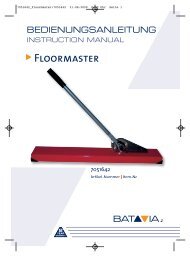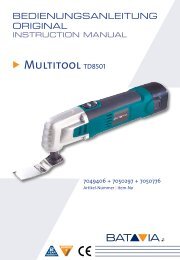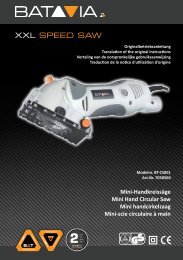Handleiding GATOR Mini-Reciprozaag
Create successful ePaper yourself
Turn your PDF publications into a flip-book with our unique Google optimized e-Paper software.
TM<br />
• When cutting wooden material, do not use<br />
too much pressure on the saw blade. If the<br />
stroke rate is too high, the cutting line will<br />
tear off.<br />
• When cutting plastics, operate the saw with<br />
a low stroke rate, or the plastic material will<br />
heat up and start to melt at the cutting line.<br />
• Use narrow blades for tight curved cuttings.<br />
• The length of the saw blade should not<br />
exceed the intended cutting length.<br />
• For flush cuttings, e.g. when sawing pipes<br />
directly on the wall, preferably use a flexible<br />
bimetal saw blade. The length of the saw<br />
blade should exceed the diameter of the<br />
workpiece you intend to cut. First, place the<br />
saw blade directly on the surface of the wall<br />
and bend the blade with sideways<br />
pressure.<br />
• Plunge sawing can only be performed in<br />
soft materials. Only use short saw blades<br />
for plunge sawing. First, cut the surface of<br />
the workpiece as usual and as soon as you<br />
have reached the necessary cutting depth,<br />
move the blade into a vertical position and<br />
continue sawing along the cutting line.<br />
INFORMATION ON SAW BLADES<br />
Saw blade for wood with 3 TPI *:<br />
- Suitable for coarse sawing of wood<br />
Saw blade for wood with 6 TPI *:<br />
- Suitable for fine sawing of wood boards<br />
and for curves or plunge cuttings<br />
Bi-metal saw blade:<br />
- Suitable for cutting light gauge ferrous<br />
and non-ferrous metals as well as for<br />
curved or plunge cuttings<br />
Universal saw blade with 10 TPI *:<br />
- The flexible blade allows flush sawing<br />
for coarse work in wood and plastics.<br />
Saw blade for plastic<br />
Saw blade for metal<br />
* TPI – teeth per inch<br />
MAINTENANCE, CLEANING AND<br />
STORING<br />
• For best performance, always keep the saw<br />
blades and the mini reciprocating saw in<br />
good and clean condition.<br />
• First unplug the mini reciprocating saw<br />
before carrying out any work on the saw.<br />
• Clean the housing with a cloth, a paintbrush<br />
or a brush to remove dust and wood<br />
splinters.<br />
• Never use benzene or similar aggressive<br />
chemicals or abrasives for cleaning, in<br />
order not to damage the surfaces of the<br />
saw.<br />
• Make sure liquids of any kind cannot enter<br />
the unit.<br />
• In regular intervals check that all screws<br />
and parts of the mini reciprocating saw are<br />
firmly secured.<br />
• Have spent carbon brushes only replaced<br />
by a professional. Always remove both<br />
carbon brushes at the same time.<br />
• Store the mini reciprocating saw indoors in<br />
a dry place that is protected from dust, dirt<br />
and extreme temperatures. Store the saw<br />
out of reach of children.<br />
Saw blade for wood<br />
16<br />
7061234 Ma # 1112-16.indd 16 16-12-11 13:31


